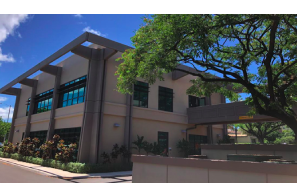Nice press release , maybe law schools should be competiting with one another worldwide to be the most energy efficient
The University of Hawai?i at M?noa William S. Richardson School of Law’s new Clinical Building has joined a dozen other structures throughout the UH System in achieving Gold Leadership in Energy and Environmental Design (LEED) status, one of the top levels of energy efficiency.
Although the building was dedicated two years ago, the U.S. Green Building Council in charge of LEED designations needed time to verify and finalize the building’s status.
Achieving Gold LEED status included:
- diversion of 86% of the on-site generated construction waste from the landfill
- sourcing 48% of the materials from the region
- access to public transportation and bicycle racks
- a reflective white roof coating
- double-pane tinted windows
- low-flow water use features
- high quality of indoor air and ventilation
- use of non-toxic and low Volatile Organic Compound paints and materials
- occupant-controlled lighting and motion sensors
- water-efficient landscaping and natural stormwater controls (bioswales)
- an overall energy cost savings of 31% from various features including 50 solar photovoltaic panels on the roof that generate about 17% of the building’s power needs
Other “green” features of the building include a specialized skylight two stories overhead that fills the lobby with natural light; native plants landscaping surrounding the building; and soundproof interview rooms offering privacy to community members served by the UH law school’s increasingly robust clinical program.
- Other UH LEED status buildings:
- P?lamanui earns LEED Platinum status for sustainable campus design, June 20, 2017
- UH Information Technology Center awarded LEED Gold, February 19, 2016
- Green building earns platinum award for C-MORE building, January 26, 2012
Contributing to a sustainable campus
When the building was dedicated in 2019, former Associate Dean Denise Antolini, who oversaw much of the decade-long funding, design and construction of the UH law school’s third building, spoke of the importance of striving for LEED status to contribute to a sustainable campus.
“Looking 30 years ahead—when this building is here but most of us will not be on this campus—I hope our successors will say that this project has truly improved the university and our island community,” Antolini said.
“Despite our very large personal and professional investment in getting this building off the ground, it’s really not about us. It’s about building a sustainable future for our students who will serve others, with professionalism and aloha, here in Hawai?i and around the world,” added Antolini.
Dean Camille Nelson said she is gratified by UH’s dedication to supporting sustainable structures, and is proud of the LEED recognition attained by the Clinical Building. She added her thanks to former Dean Avi Soifer for his dedication to the project and leadership in the multi-million dollar fundraising effort led by Honolulu attorney Mark Davis. She praised the entire team at Richardson and UH that oversaw its completion for their forward-looking vision and commitment.
“The Richardson community, its friends and supporters, came together to envision, plan and construct the new building in a way that exemplifies great care for the sustainable future of Hawai?i,” said Nelson. “They deserve our gratitude for their hard work, steadfast determination and commitment to the law school, the university and the state.”
This effort is an example of UH M?noa’s goal of Building a Sustainable and Resilient Campus Environment: Within the Global Sustainability and Climate Resilience Movement (PDF), one of four goals identified in the 2015–25 Strategic Plan (PDF), updated in December 2020.




